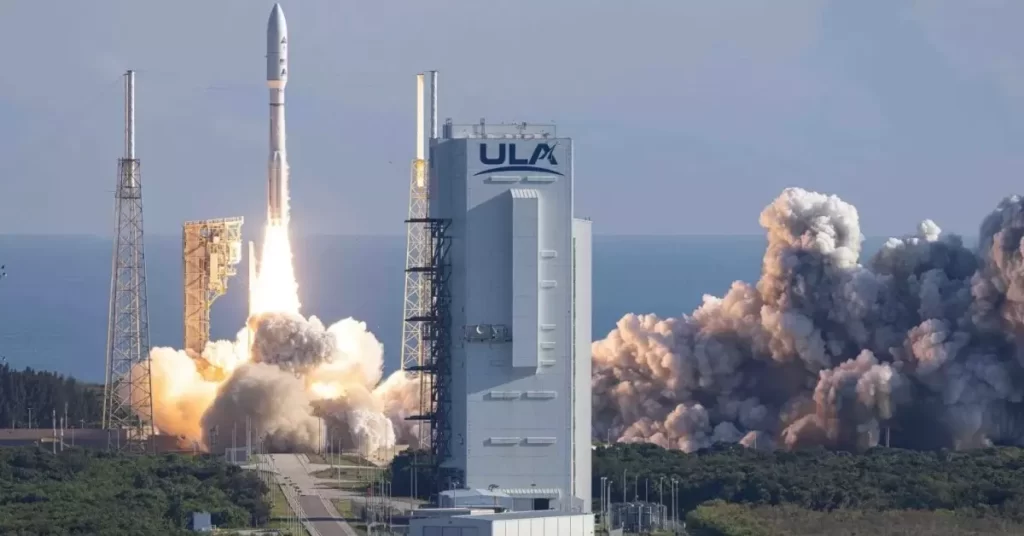Powerful ULA Rocket Launches National Security Mission Post Hurrican Idalia Delay In Florida
In a testament to technological prowess, the United Launch Alliance’s (ULA) Atlas V rocket soared into the sky from its Cape Canaveral pad in Florida, embarking on a crucial national security mission for both the U.S. Space Force and the National Reconnaissance Office. This mission marked a significant achievement, particularly because it followed a meticulous delay due to an issue discovered during a pre-launch ordnance circuit continuity check.
The initial launch attempt was scrubbed by ULA teams on a Saturday morning, the glitch prompting a careful reassessment of all systems. A day later, on Sunday morning at precisely 8:47 a.m. ET, the rocket majestically ascended into the cloudless sky, tracing an easterly trajectory over the vast expanse of the Atlantic Ocean. This launch marked the 48th liftoff from Florida’s Space Coast in the current year, underscoring the region’s pivotal role in space exploration. Notably, this mission was ULA’s 18th and final National Reconnaissance Office (NRO) mission aboard an Atlas V rocket since 2007, signifying the end of an era in rocket technology.
What made this launch especially noteworthy was the payload it carried: the SILENTBARKER/NROL-107 mission, a joint endeavor between the U.S. Space Force and the National Reconnaissance Office. At the heart of this mission was the SILENTBARKER satellite constellation network, a project of profound importance. Designed to enhance space situational awareness, orbital surveillance, and tracking capabilities, SILENTBARKER played a pivotal role in bolstering national security. Its primary function was to detect and maintain custody of space objects, providing invaluable indications and warnings of potential threats against high-value assets in geosynchronous orbit, which orbits approximately 24,000 miles above Earth’s surface.
To accomplish this mission, ULA utilized the mightiest version of its Atlas V rocket, the 551 configuration. This variant boasted a staggering 2.3 million pounds of thrust, made possible by a single main engine and five add-on solid rocket boosters. Referred to as the “Bruiser” configuration by ULA CEO Tory Bruno, this rocket stood as a testament to engineering excellence and innovation.
The journey to geosynchronous orbit demanded unparalleled power and precision, a challenge met with grace by ULA’s Atlas V rocket. Geosynchronous orbit, a location approximately 24,000 miles above Earth, required cutting-edge technology and a robust launch vehicle, both of which were encapsulated in this monumental mission. The successful launch of SILENTBARKER/NROL-107 signified a triumph of human ingenuity and a significant step forward in space exploration.
Looking ahead, ULA’s national security missions are poised for a new chapter with the advent of the next-generation Vulcan Centaur rocket. As the torch passes to this innovative vehicle, expectations are high for the continued success and advancement of space missions dedicated to ensuring the safety and security of the nation.
In the broader context of space exploration, this mission represented a testament to the collaboration between government agencies and private aerospace companies. The synergy between the U.S. Space Force, the National Reconnaissance Office, and ULA exemplified the spirit of cooperation that drives the aerospace industry forward. It showcased the dedication of scientists, engineers, and professionals who work tirelessly to push the boundaries of human knowledge and capability.
As the Atlas V rocket disappeared into the vastness of space, it left behind a legacy of achievement and possibility. The SILENTBARKER/NROL-107 mission illuminated the night sky, not just as a beacon of technological achievement, but as a symbol of the human spirit’s unyielding quest for exploration and understanding. In the quiet of space, where silence reigns, the echoes of this launch resonated with the promise of a future where the boundaries of our understanding are continually pushed, and the mysteries of the universe are gradually unveiled.
The launch also underscored the resilience of the aerospace industry in the face of challenges. Hurricane Idalia, a force of nature that threatened to disrupt the meticulous plans laid out for this mission, necessitated a temporary stand down. ULA’s teams demonstrated their expertise not only in launching rockets but also in safeguarding these marvels of engineering from the wrath of nature. The rocket was carefully rolled back to ULA’s vertical integration facility, shielding it from the storm’s fury. This precautionary measure highlighted the meticulous planning and dedication of the teams involved, ensuring that the mission proceeded without a hitch once the skies cleared.
Looking ahead, the anticipation for the next rocket launch from Florida’s Space Coast was palpable. Although details from SpaceX were yet to be confirmed, federal filings hinted at the next event—a Falcon 9 Starlink mission from Cape Canaveral Space Force Station. This upcoming launch, slated to occur during a four-hour window that opened at 8:30 p.m. EDT on Thursday, promised to continue the legacy of space exploration from this iconic location.
To sum up, the successful launch of the SILENTBARKER/NROL-107 mission stood as a testament to human ingenuity, collaboration, and determination. It echoed the spirit of exploration that has driven humanity to reach for the stars, overcoming challenges and pushing the boundaries of what is possible. As the rocket disappeared from view, it left behind a legacy of inspiration, reminding the world that even in the face of adversity, the pursuit of knowledge and the exploration of space continue to be guiding lights, illuminating the path to a future where the mysteries of the cosmos are unravelled and the wonders of the universe are unveiled.



